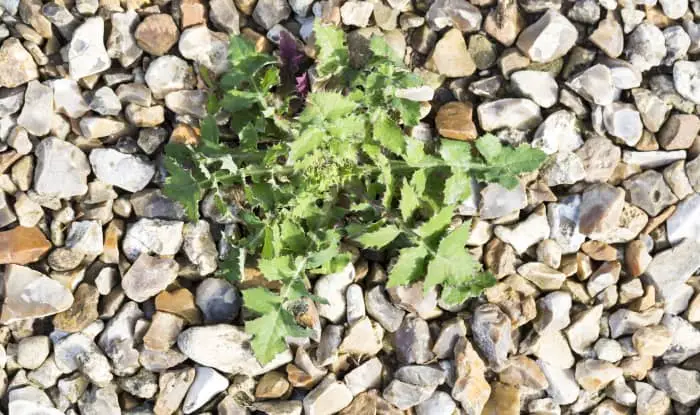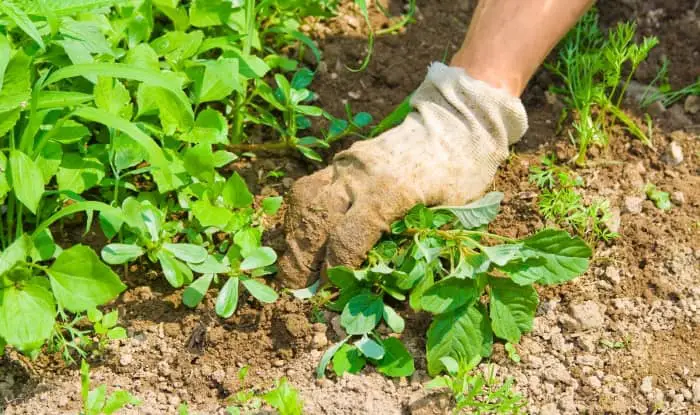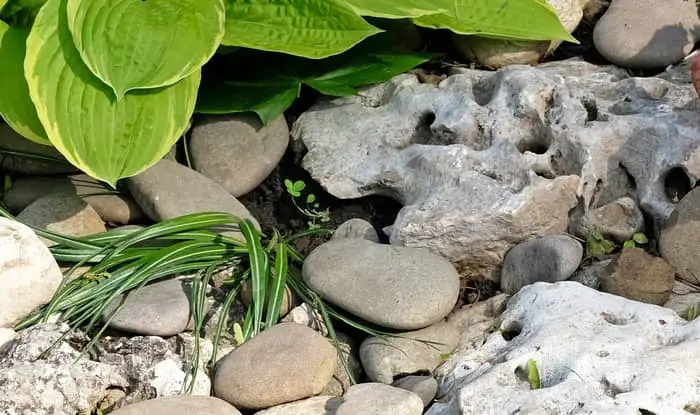Rock landscaping is one of the best ways to create a clean, tidy, and aesthetically pleasing area while minimizing maintenance.
But nowhere is safe from weeds. And unfortunately, unwanted plants still find a way to grow between the rocks, giving your yard an uncared-for appearance.
So in this article, I’ll show you how to get rid of weeds in rock landscaping using the most effective methods for weed control.
Let’s dive in.
Killing Weeds In Rock Landscaping
It’s important to kill weeds quickly when you find them growing in your rock landscaping. Weeds make the area look untidy. And if you leave them, they’re sure to spread and take over.
But there are ways to keep your rock beds weed-free. Here are methods you can use to take care of the problem:
Chemical Herbicide
One of the easiest ways to get rid of weeds in your rock landscaping is to use a chemical herbicide. They come in two types, systemic herbicides, and contact herbicides.
Systemic herbicides kill weeds to the root, preventing them from regrowing. After absorption through the leaves, systemic herbicides travel around the plant. The herbicide inhibits essential biochemical processes, causing the weed to die.
Patience is needed when using a systemic weed killer because it takes time for the herbicide to travel through the plant. After several days you start seeing results. And it’s common for it to take 2-3 weeks to kill the weed.
You can also use a contact herbicide. These work as soon as the weeds are sprayed and give fast results. But because contact herbicides only affect the parts of the plant you spray, they don’t kill the roots, and the weed may regrow. So you might have to use them again to finish the job.
Contact herbicides work well on annual weeds with shallow root systems. But for weeds with deeper root systems, such as perennial weeds, you’ll find it easier to use a systemic herbicide.
Be careful when spraying around ornamental plants, as the weed killer may cause them harm. You can use a piece of cardboard to shield desirable plants while spraying the weeds. It’s also a good idea to spray on a wind-free day so the herbicide doesn’t drift onto nearby plants and grass. If you do get herbicide on desirable plants, wash it off immediately to limit the damage.
Vinegar
A natural alternative to chemical herbicides is white vinegar. But not the sort of vinegar you use on with food. Instead, you need vinegar with a higher acetic acid concentration. Horticultural vinegar of between 15-30% will do the job.
Vinegar works as a contact herbicide, burning and killing the sprayed parts of the weed. But if the vinegar doesn’t contact the roots, the weeds might still regrow. Pouring vinegar into the root zone can sometimes kill the roots and the plant. But you’ll have to move the rocks out of the way first.
If you notice the weed regrowing, you should apply the vinegar again. If you repeatedly kill the weed as it emerges from the ground, you will prevent it from photosynthesizing, and the root system will exhaust itself.
Flame Weeding
Another quick and easy way to kill weeds growing in your rock beds is to use a flame torch. It has the benefit of being precise, so you can avoid harm to desirable plants.
Walk around your landscaped area briefly applying the flame torch to the weeds. You don’t need to incinerate them. The heat from the torch causes the plant cells to burst.
For large, well-established weeds, you’ll need to stop to ensure the flame passes over the different parts of the plant.
A good time for flame weeding is when it’s damp outside. You’re less likely to set fire to dry debris. And opposite to what you might expect, the moisture increases the effects.
Pull The Weeds By Hand
It’s the simplest way to get rid of weeds, and it’s one of the most effective when done right. The main drawback is that it takes a lot of work. Particularly when dealing with overgrown weeds.
Pulling weeds by hand is more effective against annual weeds with shallow, fibrous root systems. It’s easier to pull shallow roots out of the ground without leaving any pieces that can regrow into a new plant.
Weeds with deep and extensive root systems are difficult to remove by hand as you’re more likely to leave pieces of roots and rhizomes in the soil. But if you clear the rocks out of the way, you can use a garden tool to help you, such as a spade.
When pulling garden weeds by hand, it helps if the ground is wet. Try to pull the weed out as close to the base as you can. Grabbing hold of weeds halfway up the stalk is likely to make them break, leaving the root system in the ground.
Salt
If you don’t want anything to grow in the area, then applying salt to the ground can kill the weeds.
Salt makes the soil unsuitable for plant growth. To use salt, mix it with water at a ratio of one cup of salt to three of water and pour it between the rocks into the ground around the weeds.
The problem with using salt is the effects last a long time. So, be sure that you don’t want to plant in the rock landscape. And because it can leach into nearby garden areas, it can affect desirable plants as well as the grass on your lawn.
Boiling Water
A simple homemade remedy for weeds is to douse them in boiling water. Boiling water kills the parts of the plant it contacts. And if you pour it into the ground around the weed, it can also cause damage to shallow roots, preventing weed regrowth.
But although boiling water is effective on small, young weeds, it won’t work as well on large, well-established plants. Or weeds with deep taproots, such as dandelions, which will still regrow.
Baking Soda
Baking soda is another simple to use weed killer. Here’s how you can use it:
- First, spray the weeds with water, this helps the baking soda stick to the plant.
- Then sprinkle the baking soda over the foliage.
- If the plant continues to grow, repeat the treatment after 4-6 weeks.
Be careful not to get baking soda on desirable plants as it can harm them as well. And because baking soda makes soil conditions inhospitable to plants, you should minimize the amount of baking soda that gets in the soil if you want to grow anything in the area.
How To Prevent Weeds In Landscaping Rock
Here are some methods you can use to prevent weeds from growing in your rock landscaping:
Weed Preventer
The best way to stop broadleaf weeds and grass from growing in your rock garden is to use a pre-emergent herbicide. When applied at the correct times of the year, pre-emergent herbicides prevent weed seeds from developing after germination.
Pre-emergent herbicide works by forming a chemical barrier in the soil. When the shoots and roots of the seedling come into contact with the chemical, the weed dies.
To prevent summer-annual weeds, the best time of year to apply pre-emergent herbicide is in early spring. Apply the pre-emergent when soil the temperatures reach 55°F for several days in a row.
To prevent winter-annual weeds, apply the pre-emergent in late summer to early fall. A good time to use the pre-emergent is when soil temperatures reach 70°F.
Sometimes you might need to reapply the pre-emergent herbicide after 8-10 weeks.
Pre-emergent herbicide is good for preventing weeds that develop from seed. But it doesn’t have much effect against perennial weeds that grow back from established root systems each year.
Pre-emergent herbicides are usually safe to use around shrubs and flowers. But some pre-emergents can harm herbaceous ornamentals. So it’s important to choose the right one to use in your rock landscaping.
Another problem is getting even coverage of the area when applying the pre-emergent. You can spread it over the rocks. Then water the pre-emergent to activate it, causing the herbicide to seep between the rock cracks. The herbicide will prevent weeds developing in the dirt that settles between rocks. But not all of the ground will be covered, providing the opportunity for weeds to occasionally grow through gaps. So you might still need to spot treat with a post-emergent herbicide during the growing season.
Steel Edging
Erecting a steel border around the edge of your rock landscaping can prevent invasive weeds from spreading into the area.
Steel edging helps to keep your landscaping separate from your lawn and garden and prevents weeds that spread by runners and rhizomes.
Weed Barrier Fabric
Weed barrier fabric is a popular way of preventing weeds from growing in landscaped areas. You lay the fabric on top of the ground before applying the rocks. It works by preventing light from reaching the ground, making it hard for weed seedlings to develop after germination.
But it also has drawbacks:
- Some weeds still manage to poke through the barrier, making it harder to remove them.
- The landscape fabric disintegrates over time, so you need to replace it every few years. Replacement can be a big job as you need to remove all the rocks first.
- Weed seeds can germinate in dirt accumulated on top of the barrier.
You can also use cardboard underneath the rocks as a weed barrier. But it will decompose and need replacing periodically.
How To Get Rid Of Weeds In Rock Landscaping – Final Thoughts
The best way to keep your rock landscaping weed-free is to prevent them from growing and then spot treat weeds that manage to emerge.
The combination of using pre-emergent herbicide at the right times of year followed by post-emergent herbicides is a popular way of controlling weeds in rock landscaping. It’s both effective and reduces your amount of work.



This year we are seeing beautiful established plants becoming weak with sections of dead and struggling plant portions in our rock covered flower beds. We have had a gardener use the pre-emergent and systemic weed control products for several years now and I am wondering if the accumulated contents of the chemicals might be responsible for the failing plants. The struggling bushes seem to often be at the ends of the rows of formerly healthy lines of established plants. I have had some of them fertilized professionally over the past years. A row of eight large old Rose of Sharon bushes is particularly struggling this year. It has been magnificent in past years. We have a large yard with many beds so pulling the weeds by hand, which we have done in the past, is beyond our ability. Hiring others would be difficult I am afraid.